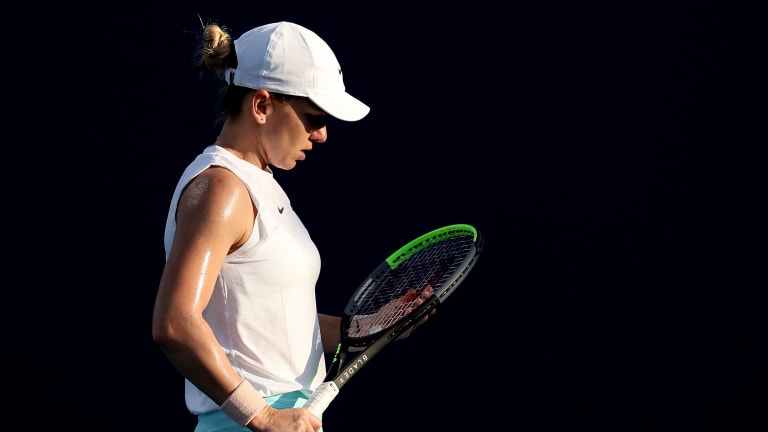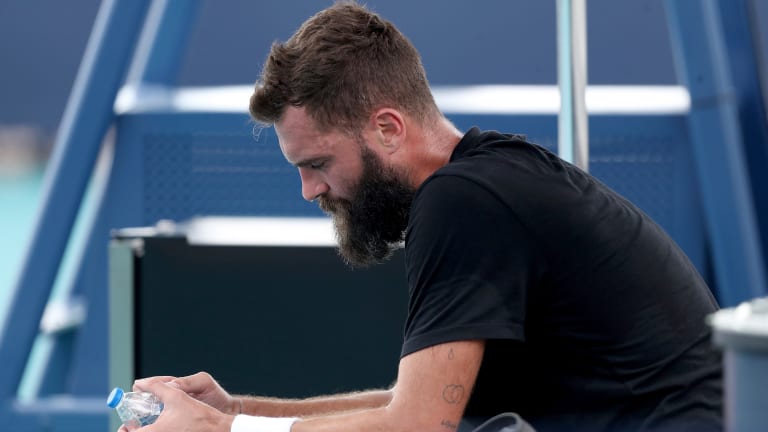Acing depression: How pros can manage ongoing tennis bubble
By Jordaan Sanford Apr 01, 2021Can champion Iga Swiatek bring consistency, too?
By Steve Tignor May 26, 2021The Tennis Conversation: Tim Henman
By Matt Fitzgerald May 21, 2021Debating best-of-three sets vs. best-of-five
By Steve Tignor May 21, 2021Polish phenom Iga Swiatek rules in Rome
By Joel Drucker May 16, 2021Flawless Final: Iga Swiatek double bagels Karolina Pliskova in Rome
May 16, 2021Pliskova powers past Martic to reach third consecutive Rome final
By Jordaan Sanford May 15, 2021Iga Swiatek wins twice to reach Rome final, now a win away from Top 10
By John Berkok May 15, 2021Elina Svitolina holds off Garbiñe Muguruza to complete Rome QF line-up
By David Kane May 13, 2021Gauff relishes flawless performance with Barty matchup looming
By Steve Tignor May 13, 2021Acing depression: How pros can manage ongoing tennis bubble
With tennis’ new normal being exceptionally stressful, players have vocalized their concerns about the cumulative toll of living as a globetrotting athlete amid a pandemic.
Published Apr 01, 2021
Advertising
The Miami Open has long given pro tennis players the chance to occupy two contrasting and compelling worlds. There’s a high-stakes tournament and all of its attendant pressures and opportunities. Away from the tennis, Miami provides a sparkle all its own—Florida’s everlasting spring break, offering all the sizzle of a cosmopolitan city by the ocean, complete with a captivating nightlife, eclectic restaurants and clubs, tourist attractions and many more colorful sights and sounds. It’s an alluring spectrum of work and play, likely to make many players occasionally ponder life as just another 20-something instead of a laser-focused athlete worried less about finding another party and more concerned with the next morning’s practice session.
But Miami’s getaway dimension and all its relaxing benefits are off the table this year. As was the case at the US Open, the players occupy a bubble, shuttling back and forth between hotel and a tournament site with minimal fan attendance. Total prize money is also considerably less. Roger Federer and Ashleigh Barty each earned $1.35 million when they won the singles title in 2019. This year’s champion will take home just over $300,000. A couple of weeks after Miami, the traveling tennis circus heads across the Atlantic to Europe and its vast range of COVID-related protocols—all alongside gearing up for the sport’s most physically demanding tournament, Roland-Garros.
With tennis’ new normal being exceptionally stressful, players have vocalized their concerns about the cumulative toll of living as a globetrotting athlete amid a pandemic. “This period is not easy for everybody,” said Simona Halep as Miami got underway. “I don’t believe that all players can perform at the highest level they can offer.” Alas, Halep withdrew from the tournament on Saturday with a right shoulder injury.
Denis Shapovalov addressed the situation with despondency. Earlier this month, in Dubai, the Canadian lefthander expressed appreciation for the tournament’s bubble, but also said that, “It’s still difficult, you’re looking across the pond and you’re looking at regular life and you feel like you’re kind of in an aquarium.” Shapovalov also believes that with less prize money being available, withdrawals will increase.

Getty Images
© Getty Images
Advertising
And then there’s Benoit Paire, in a league of his own when it comes to concurrently resenting confinement and disrespecting the sport that has rewarded him with more than $8 million in career prize money. “I lost in the first round, it’s better, I will be able to get out of the bubble quickly and enjoy a few days before Miami,” he said in Acapulco earlier this month. “Tennis is not my priority for the moment. Getting out of the bubble is the only goal I have at every tournament.” Mission accomplished: after receiving a first round bye, the 23rd-seeded Paire lost in the second round of Miami, putting in a meager effort versus the ascending young Italian, Lorenzo Musetti. He also went out immediately in the doubles, paired with Rohan Bopanna.
Great Britain’s Dan Evans sees things differently. “You know, there’s way too [many] other things happening in the world right now,” he told ATP Tennis TV just prior to Miami. “Some—well—us tennis players do like to moan a lot, but I can’t sit here and moan about bubble life.”
Longstanding coach Nick Bollettieri offers even more strident advice to stressed-out pros. “Sure, it’s difficult,” he says, “but just think about the people that can’t do anything. They’re at zero. You, you have the chance to play in tournaments. You’re lucky.”
But regardless of how the current situation is viewed, there’s no question that much has changed and it’s likely to continue in such treacherous flux for a good deal of 2021. To occupy and adjust in such an environment is not easy. “When you play tournaments, you want to get into a flow state and in the zone,” says Jeff Greenwald, a sports psychologist and author of the book, The Best Tennis of Your Life. “That doesn’t just happen the minute you get on to the court. It’s the buildup from the meal and the morning and everything else. But now, you’re getting tested and it’s ominous, threatening, you’ve got the mask on and you’re breathing into it. It’s a bit stifling and not easy to find that flow.”
One major way to stay in harmony is to address such matters as the hotel room and how to best use it given the need to now occupy that lonely space for far more hours than usual.

Getty Images
© Getty Images
Advertising
“Things like journaling and writing can be a good outlet to relieve feelings,” says ex-pro Stacy Margolin Potter, who currently works as an integrative health nutrition coach. Margolin also believes it’s more vital than ever to surround oneself with healthy foods. “It’s one thing to go out for a treat, but you don’t want those high sugars in the hotel room. Better to have fresh fruits near at hand.” Bill Norris, a trainer on the tour for 35 years, echoes Margolin in now viewing the hotel room as something other than a place to sleep. “Some people use the hotel room as a gym, which is great,” says Norris. “But also take advantage of things like FaceTime and Zoom and use them creatively.”
As former WTA pro and psychologist Julie Anthony notes, “Pro tennis is stressful period, just on its own. It’s fabulous and it’s stressed . . . with the pandemic stuff, it’s much like the general population: Some people are incredibly paranoid—and then there are others who are far more relaxed.”
Anthony and Greenwald both believe the best path is one of acceptance, akin to dealing with long rain delays at Wimbledon, windy court conditions, or any other intrusion on the desire to conduct tennis business in as ritualistic a way as possible. “Inconveniences are now the new normal,” says Anthony. “Once you get used to the new routine, you can find it calming.” Says Greenwald, “See it as an opportunity, even if it’s not easy.”
And then there’s matter of turning an individual sport into a community. Time was when players largely traveled by themselves, creating support systems among their opponents – not always an easy environment (or era) for baring one’s soul. Cliff Richey, No. 1 in the U.S. in 1970 and author of the memoir, Acing Depression, believes the culture of the tour is much healthier in grappling with stress. “The way the pro tour is now, there seems to be a team that they have,” says Richey. “Whoever a player feels close to, whether it’s their mother, coach, massage therapist or hitting partner, that person should be able to help you talk it out.”
Leave it to Martina Navratilova to have the last word. As she once said, “In tennis, there are only two things you can really control: Your toss and your attitude.”